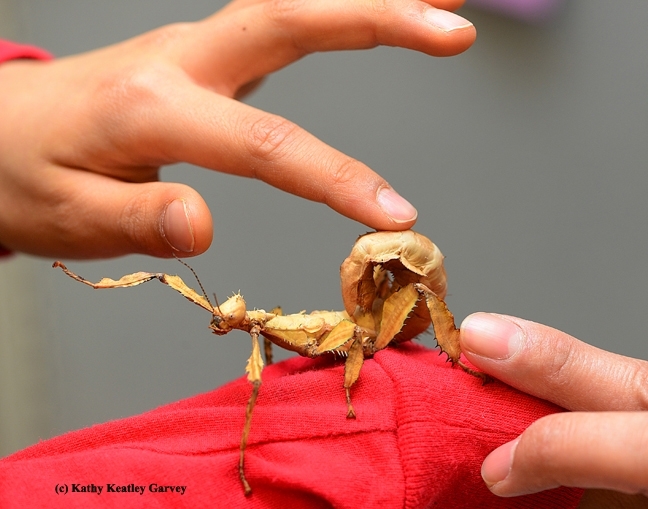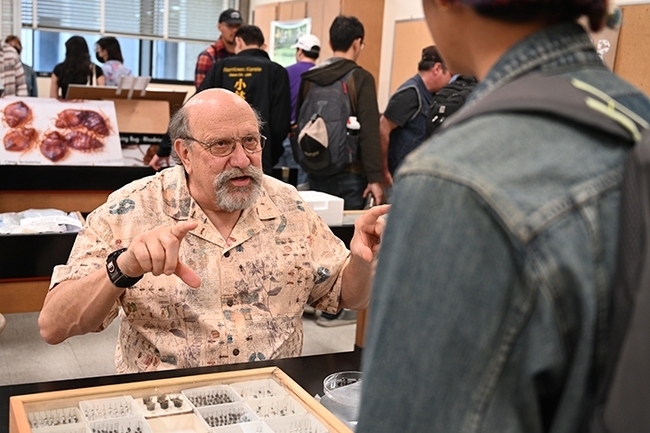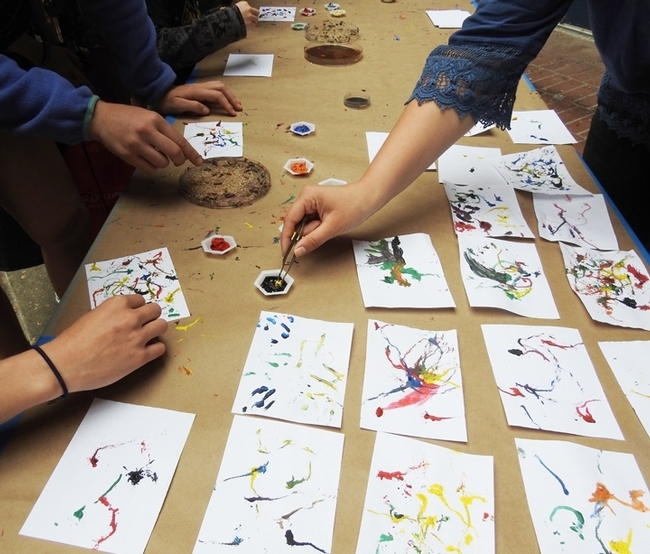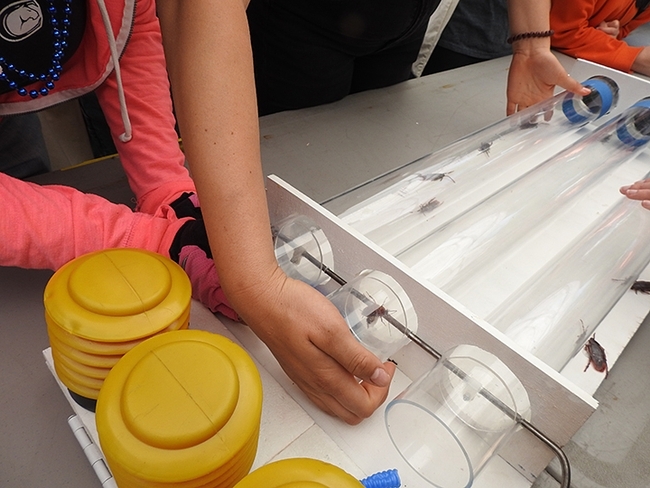- Author: Kathy Keatley Garvey
Show me the honey? Show me the California Honey Festival.
The annual event, which emphasizes the importance of bees, and promotes honey and honey bees and their products, will take place from 10 a.m. to 7 p.m., Saturday, May 4 in downtown Woodland.
It's free and family friendly. It traditionally draws a crowd of some 40,000.
Amina Harris, who retired last June as director of the UC Davis Honey and Pollination Center, co-founded the honey festival in 2017 with the City of Woodland. She actually "retired" to the family business, Z Food Specialty and The HIVE, Woodland, where her title is "Queen bee."
The California Honey Festival continues to partner with the Honey and Pollination Center in presenting the festival.
The organizers promise "something for everyone." You can expect honey tastings, bee observation hives, kids' activities, cooking demonstrations, live music, vendors and much more. The UC Davis-based California Master Beekeeper Program, which uses science-base information to educate stewards and ambassadors for honey bees and beekeeping, will not be participating this year. But science-based information on bees will be provided by the California State Beekeepers Association and the Sacramento Area Beekeepers' Association.
Ask them questions! And remember you can sign up for classes with the California Master Beekeeper Program (CAMPB), founded (2016) and directed by Elina Lastro Niño, associate professor of UC Cooperative Extension, apiculture. She is a member of the faculty of the Department of Entomology and Nematology. As the CAMPB website indicates: The organization is "a continuous train-the-trainer effort. The CAMBP's vision is to certify Honey Bee Ambassador, Apprentice, Journey, and Master level beekeepers so they can effectively communicate the importance of honey bees and other pollinators within their communities, serve as mentors for other beekeepers, and become the informational conduit between the beekeeping communities throughout the state and UCCE staff. Explore the Certifications Page for more information."
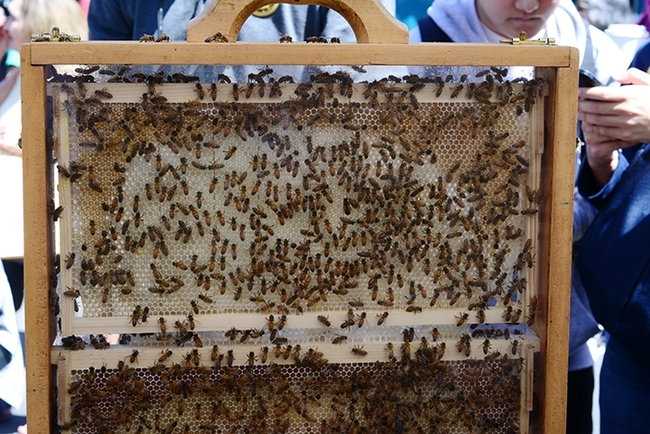

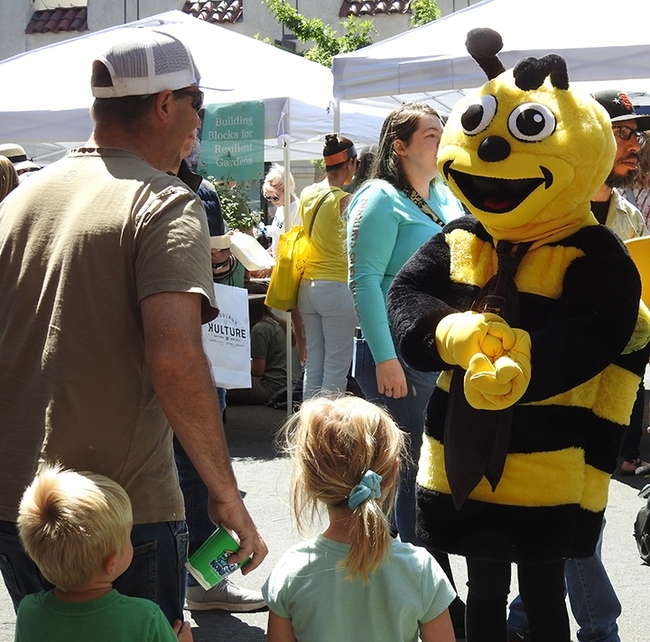
- Author: Kathy Keatley Garvey
An image of a damselfly photographed in Hawaii, and images of a blowfly and a monarch photographed in California won the Photo Salon recently hosted by the Pacific Branch, Entomological Society of America (PBESA)
Photo Salon coordinator Joshua Milnes, an entomologist with the Plant Protection Division, Washington State Department of Agriculture, Yakima, announced the winners as:
- First, Robert Peck, entomologist with the University of Hawaii, for his image of a damselfly
- Second, Alexander Nguyen, a UC Davis entomology alumnus, for his image of a blowfly
- Third, Kathy Keatley Garvey of the UC Davis Department of Entomology and Nematology, for her image of a monarch.
PBESA showcased the images at its annual meeting, held April 14-17, in Waikoloa Beach, Hawaii. The photo competition, themed “Pineapple Madness,” was open to all PBESA members. Membership covers 11 Western states, plus U.S. territories and parts of Canada and Mexico.
Winning entrants in this year's competition "not only received bragging rights," Milnes said, but also cash prizes. The first-place winner received $50, plus a printed photo; second place, $25, plus a printed photo, and third place, $25.
Robert Peck
“The damselfly in my photo is Megalagrion calliphya, with the common name, Beautiful Hawaiian Damselfly," said Peck, an entomologist with the Hawaii Cooperative Studies Unit, University of Hawaii, Hilo. “It can be found around standing pools of water in Hawaiian forests.” Peck captured the image in his backyard in Volcano, Hawaii. This was his first submission in the Photo Salon competition. His camera gear: a Canon EOS 7D Mark II with a Tokina 90 macro lens.
Alexander Nguyen
“I took this image (of a blowfly) while visiting my good friend, and fellow UC Davis entomology alumnus Joel Hernandez, in Woodland," Nguyen said. "I'm a long time user of Canon cameras and have no plans to switch. This was photographed using the newer R5 mirrorless model. I currently reside in Sonoma County serving that region in the Agricultural Commissioner's office.” This was his third win in an ESA-hosted competition. Nguyen's image of a hoverfly, photographed in the UC Davis Stebbens Cold Canyon Reserve, won an international competition and appeared in the ESA 2018 Insects of the World calendar. (See Bug Squad blog) In 2022, his photo of red imported fire ants placed second in the PBESA Photo Salon.
Kathy Keatley Garvey
Garvey, a communications specialist with the Department of Entomology and Nematology, captured her image of a monarch foraging on milkweed in a Vacaville garden. Her camera gear: a Nikon D500 with a 200mm macro lens. She earlier won several awards in ESA-hosted competitions. Her image of a golden dung fly, Scathophaga stercoraria, won the Entomological Society of America (ESA) medal for "Best Image by an ESA Member" in the 64th annual International Insect Salon competition, held in 2022. Her image of two Melissodes agilis bees buzzing over a sunflower, Tithonia rotundifola, won "Best Image by an ESA member" at the 63rd North Central Insect Photographic Salon, co-sponsored by the North Central Branch of ESA and the Photographic Society of America. Two other Garvey images also won acceptances in the North Central competition.
Entries are now being accepted through May 12 for the 2025 ESA World of Insects Calendar. "Photographers of all backgrounds, areas of expertise, career stage, and geographical location are invited to submit photos," according to the ESA website. "No entomological training or expertise is required, and you do not need to be an ESA member to enter." Submitted images may also be considered for ESA's weekly "Arthropod Photo of the Week" feature on social media, via the #arthropodPOTW hashtag on Twitter, Facebook, Instagram, and Mastodon.
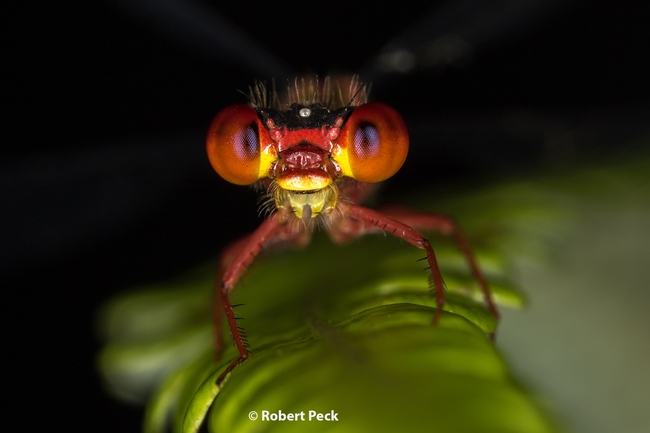
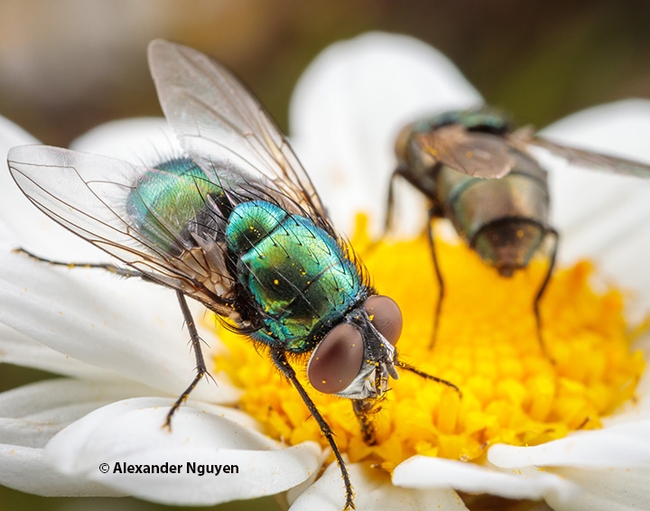
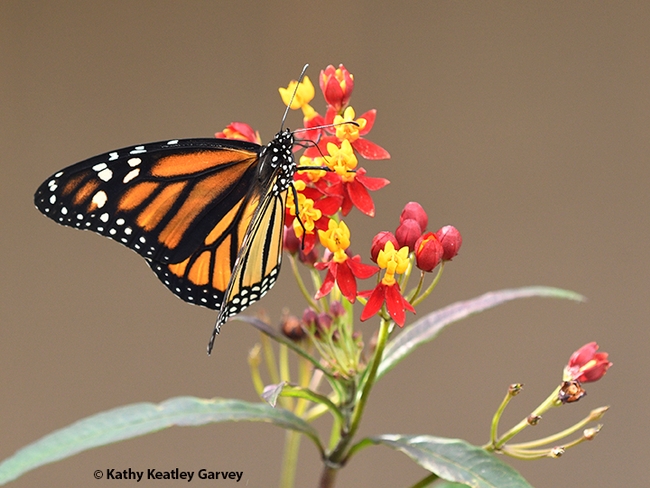
- Author: Kathy Keatley Garvey
There is no "Planet B."
The Earth is all we have.
Today, April 22, is Earth Day (an annual event launched April 22, 1970) and what a perfect occasion to celebrate a native bee and a native wildflower.
Bombus vosnesenskii,aka the yellow-faced bumble bee, meet the California golden poppy, Eschscholzia californica, the California state flower. (The California dogface butterfly, Zerene eurydice, is the state insect, but shouldn't B. vosnesenskii rank as a runner-up?)
Why do we celebrate Earth Day? "To demonstrate support for environmental protection," according to Wikipedia. "In 1969 at a UNESCO Conference in San Francisco, peace activist John McConnell proposed a day to honor the Earth and the concept of peace, to first be observed on March 21, 1970, the first day of spring in the northern hemisphere."
The late Robbin Thorp (1933-2019) distinguished emeritus professor, UC Davis Department of Entomology and Nematology, always encouraged us to look for, photograph and celebrate bumble bees. A tireless advocate of pollinator species protection and conservation, Thorp was known for his expertise, dedication and passion in protecting native pollinators, especially bumble bees, and for his teaching, research and public service. In his retirement, he co-authored two books Bumble Bees of North America: An Identification Guide (Princeton University, 2014) and California Bees and Blooms: A Guide for Gardeners and Naturalists (Heyday, 2014).
Seen any bumble bees lately? Connect with the California Bumble Bee Atlas. It's a project coordinated by the Xerces Society for Invertebrate Conservation. As its website says: It's a "collaborative community science effort to track and conserve the state's native bumble bee species.? ?This year's field work starts March 15, 2024!" Grants from the U.S. Fish and Wildlife Service's Wildlife and Sport Fish Restoration, the Bureau of Land Management, and other agencies support the project.
Happy E. Day...and Happy B. Day!
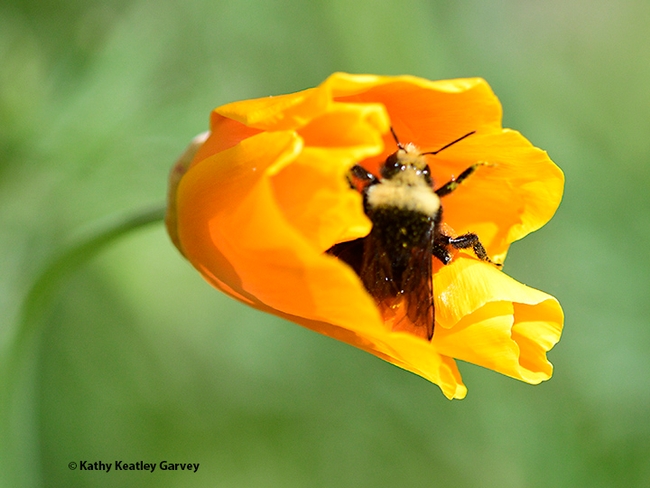
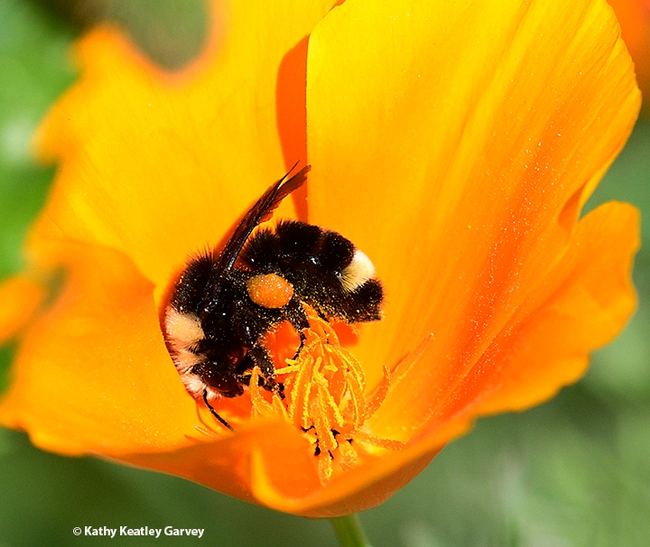
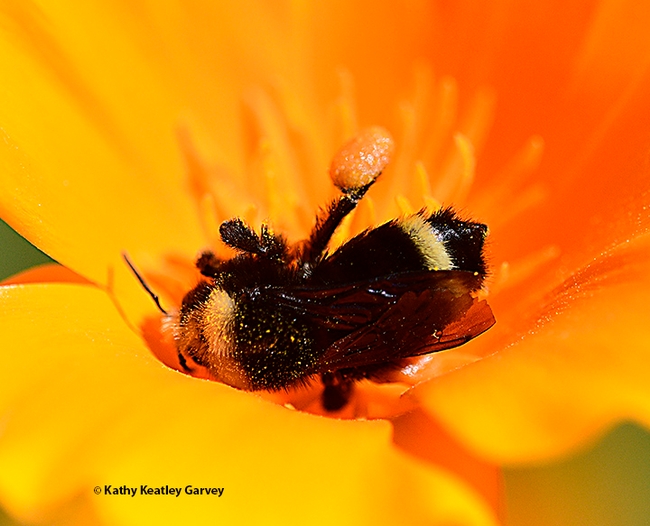
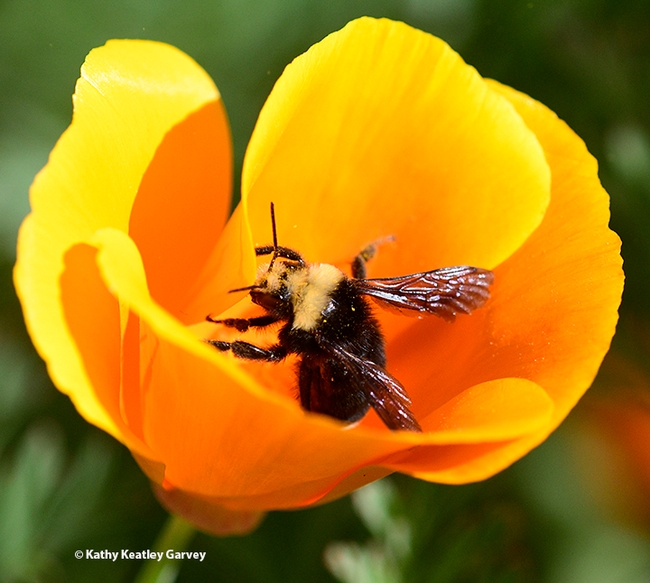
- Author: Kathy Keatley Garvey
Remember when San Francisco 49'ers wide receiver Brandon Aiyuk credited his spectacular 51-yard catch in the 2024 NFC championship game with the Detroit Lions to a ladybug (note that entomologists correctly call it a "lady beetle") landing on his shoe before the game?
Well, those attending the 110th annual UC Davis Picnic Day activities on Saturday, April 20 at Briggs Hall--home of the UC Davis Department of Entomology and Nematology--can also net some luck.
Children are encouraged to take home a couple of the beetles at the UC Statewide Integrated Pest Management Program (UC IPM) booth in the courtyard of Briggs. (Adults can do so, too. Maybe they'll name their beetles "Brandon" and "Aiyuk.")
The ladybug is actually a beetle (Coleoptera), not a bug (Hemiptera). It's associated with good luck because it eats the aphids that try to destroy our crops. It can eat as many as 5000 aphids in its lifetime, scientists estimate.
"These beetles have become a cultural icon of sorts because of their appearance and their beneficial habits," writes UC Davis distinguished professor Lynn Kimsey, former director of the Bohart Museum of Entomology, in her insect fact sheet on lady beetles. "Both adults and larvae feed on aphids and other small, soft-bodied insects...They are ferocious predators on small insects." (See what the UC Statewide Integrated Pest Management Program says about lady beetles.)
Ever seen a close-up shot of a lady beetle eating an aphid? The predator and the prey...
Ever seen a cellar spider snaring and eating a lady beetle? The predator and the predator...one becomes prey.
Ordinarily, the lady beetle's bright red coloration serves as a "warning" to predators. Plus, lady beetles are known to ooze a foul-tasting chemical that tastes so bad that predators leave them alone. This lady beetle engaged in "reflex bleeding," exuding an alkaloid toxin (which did not deter the predator).
Lady beetles will be just a few of the bugs at Briggs Hall during UC Davis Picnic Day. You'll also see cockroach races, maggot art, and displays featuring ants, bees, walking sticks, mosquitoes, nematodes, butterflies, spiders, whip scorpions, and more. Check out "bug" activities at Briggs Hall here. UC Davis Picnic Day is free and family friendly.
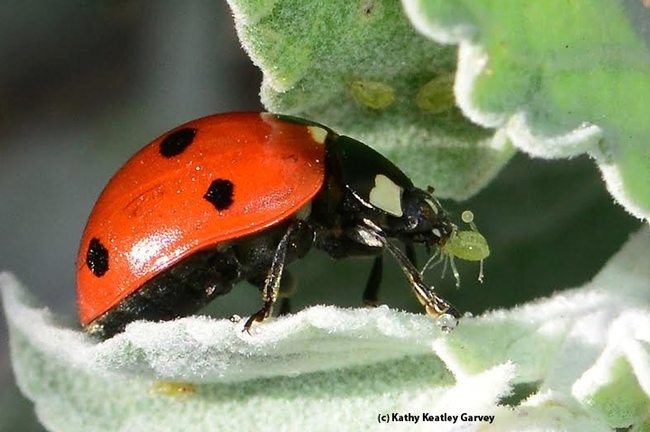
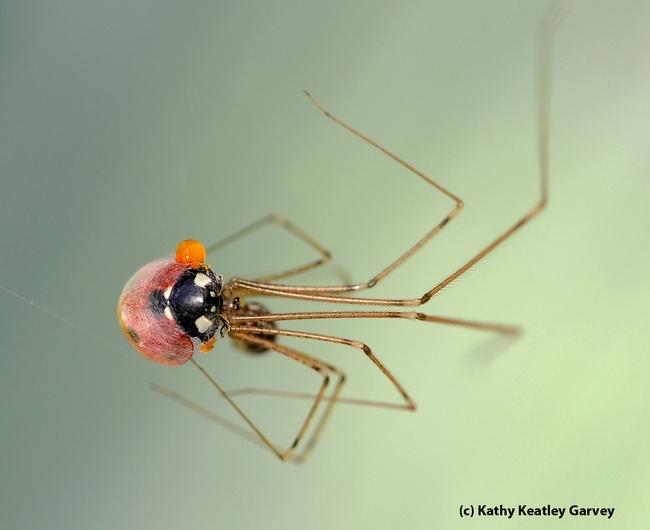
- Author: Kathy Keatley Garvey
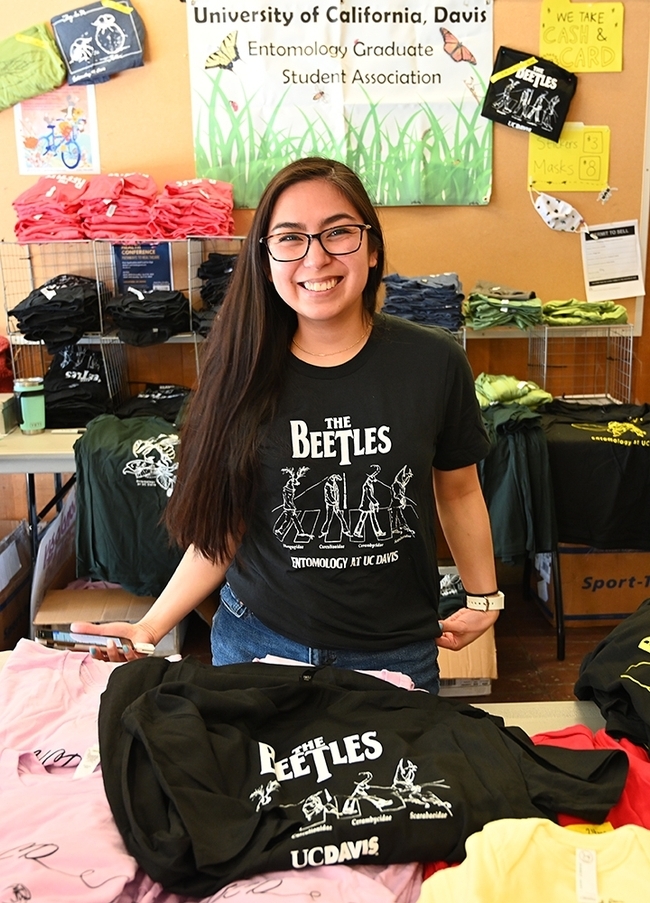
Well, it wouldn't be a picnic at all!
The UC Davis Department of Entomology and Nematology (ENT) is planning scores of displays and activities at Briggs Hall for the 110th annual campuswide UC Davis Picnic Day, to take place Saturday, April 20.
Think ants, bees, beetles, butterflies, flies, cockroaches, maggots, mosquitoes, nematodes, spiders and scorpions.
And more.
This year, all of the entomology exhibits, including those at the Bohart Museum of Entomology, will be at Briggs Hall. (The Bohart Museum headquarters in the Academic Surge Building will be closed on Picnic Day.)
Hours? From 9 a.m. to 5 p.m. The Bohart Museum's pop-up tent in front of Briggs, featuring insect specimens and an insect petting zoo, will be open from noon to 4 p.m.
The entomology displays traditionally draw some 3000 attendees, said the ENT co-chairs, doctoral student Grace Horne of the Emily Meineke lab, and faculty member and forensic entomologist Robert "Bob" Kimsey. It's all free and family friendly.
Among the crowd pleasers are the cockroach races, maggot art, stick insects, and the Bug Doctor booth. The doctor is always in!
New to the line-up is the “I IUV Bugs," an exhibit about plant-insect interactions under ultraviolet light. The "glowing bugs exhibit" is the brainchild of Horne and primarily designed by the Meineke lab, "especially (doctoral student) Marielle Hansel Friedman," Horne said. "We will have plants from the UC Davis Arboretum Teaching Nursery and local/pet-trade arthropods which glow under ultraviolet light. With this exhibit, we seek to highlight the interplay between light, color, and species interactions."
Doctoral student Veronica Casey of the Shahid Siddique lab designed the new nematode exhibit. Carla-Cristina "CC" Melo Edwards of the Geoffrey Attardo lab is coordinating the new medical entomology display. "The bumble bee observation hive is unfortunately not ready for the spotlight this year," Horne said.
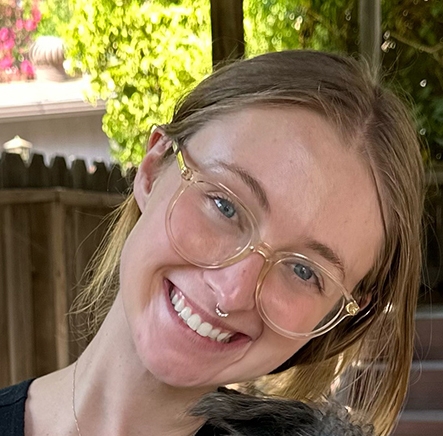
Bug Doctor
Briggs Hall Entryway
Graduate students will answer questions about insects. What's that bug? Attendees are encouraged to bring an insect or photo for identification.
Cockroach Races
Front of Briggs Hall
American cockroaches, Periplaneta americana, from Bob Kimsey's forensic lab, race on a specially made track, while roach fans cheer for their favorites. (Sometimes the athletes are named for faculty, friends or bystanders.)
Medical Entomology
122 Briggs Hall
Carla-Cristina "CC" Melo Edwards of the Geoffrey Attardo lab is coordinating the medical entomology display. Her research focuses on investigating the physiological mechanisms underlying pyrethroid resistance in Aedes aegypti (the yellow fever mosquito).
Diversity of Arachnids
122 Briggs Hall
Doctoral student Emma Jochim of the Jason Bond lab is coordinating an exhibit she created last year to display the diversity of arachnids, such as vinegaroons, whip spiders, tarantulas, and scorpions. "We'll have live animals and fact sheets that will give a general overview of their diversity, behavior, and habitat," Jochim said. "I'll also bring some curated specimens to show what goes into creating a scientific collection and talk about why collections are important for understanding biodiversity. "
Maggot Art
Briggs Courtyard
Artists--children and adults alike--create maggot art by dipping a live maggot into water-based, non-toxic paint. It's suitable for framing (or at least a spot on the refrigerator door). This event will close at 3 p.m. this year (last year it was at 5 p.m.)
Dr. Death
122 Briggs Hall
Forensic entomologist Robert Kimsey will display and discuss his work in his "Dr. Death" booth. Last year Kimsey pin-mounted and identified flies from various cases and research efforts, and displayed studies on the sequence of development of individual maggots, calling attention to the development and sequence of communities of insect maggots. "By these means, approximations about how long a person has been dead can be made," he told the crowd.
Entomology at UC Davis
122 Briggs Hall
Displays of insects, including bees, ants and more. Graduate students, faculty and emeriti will staff the tables.
Bohart Museum of Entomology
Front of Briggs Hall
A pop-up tent, staffed by the Bohart Museum, will include stick insects (walking sticks) and Madagascar hissing cockroaches. "We are excited to be part of the bigger department's offerings," said Tabatha Yang, education and outreach coordinator. Give-aways are also planned.
Fly-Tying
Briggs Hall courtyard
Fly Fishers of Davis will show attendees how to tie a fly. The recipients take home the flies.
Insect-Themed T-Shirt Sales
Briggs Hall entryway
Members of the Entomology Graduate Student Association (EGSA), led by president Mia Lippey, will be selling their popular insect-themed t-shirts, including The Beetles. The T-shirt, EGSA's all-time best seller, is a take-off of the cover of The Beetles' Abbey Road alum. However, instead of the Beatles crossing the road in a single file, four beetles (family names Phengogidae, Curculionidae, Cerambycidae and Scarabaeidae) do so.
Mosquito Control Booth
Entrance to Briggs (below front steps)
Sacramento-Yolo Mosquito and Vector Control District will be providing information on mosquitoes, answering questions, and handing out give-a-ways, including mosquito repellent.
UC Statewide Integrated Pest Management (UC IPM)
Briggs Hall Courtyard
“We plan to have many of our usual materials on display and will be giving out the live lady beetles (aka ladybugs) again,” said urban and community IPM educator Lauren Fordyce. “We purchase them from a local garden center. In addition to that, we plan to have a prize wheel that adults and kids can spin, answer a question, and win a prize if they answer correctly. We may also have temporary insect tattoos to give away.”
Ranked Third in the Country. The UC Davis Department of Entomology and Nematology is ranked third among “The Best Entomology Colleges in the United States for 2024" by universities.com. The department includes 24 active and 19 retired faculty; 28 graduate students (five in the master's degree program and 23 in the doctoral degree program); 47 undergraduate entomology majors (based on the Office of Academic Support and Instructional Services (OASIS) Student Reports); and a staff comprised of 27 academics (non-faculty), 24 career, and 56 student assistants. Professor and chair of the department is molecular geneticist and physiologist Joanna Chiu.
